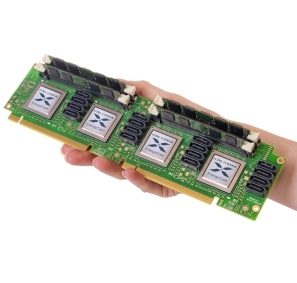Crafting Efficient Big Data Solutions
By: Chris Piedmonte

Advancements in chip technology have brought about the dawn of the age of the microserver. This next generation of server technology is poised to more effectively tackle the issues of cost performance, reliability, space, and power consumption.
Current information-technology systems based on Hadoop, MongoDB, Cassandra, and other products that are designed to manage Big Data require significant parallel processing power to get through extremely large volumes of data required to gain tactical and strategic business insight. These systems require dozens of, if not many more, commodity servers to do the job. Primarily based on x86 CPU technology such as Intel Xeon or AMD Opteron microprocessors, these solution can be extraordinarily large, power hungry and challenging to manage because they’re made up of thousands of discrete components, interconnects, cables, and individual chassis. As a result reliability and continuous availability can be difficult to maintain.
In contrast, microservers made possible by hyperscale-integration and system-on-a-chip (SoC) designs provide enterprise-class servers on a single substrate. These next-generation servers come with high-performance, ARM-based CPU cores, a disk controller, and memory management, making them ideal for massively parallel applications in Big Data. Deployed in high-density chassis, SoC designs require far fewer components than current IT systems, provide integrated, high-speed fabric networks and greatly reduce space and power requirements. By using advanced SoC technology, Big Data systems can be deployed on microserver clusters with significantly high cost performance.
SoC vendors
Over the past few years several companies have entered the SoC market. The first to provide an SoC design for a generally available microserver platform was Calxeda: announced in November 2011, its EnergyCore ECX-1000 SoC is based on four ARM Cortex-A9 cores running at speeds of up to 1.4 GHz.
The design includes an 80 Gbps crossbar fabric switch capable of connecting up to 4,096 nodes, and five separate 10 Gbps external channels. It also provides support for up to five direct-attached SATA devices, four Gen2 PCI Express controllers and a wide collection of I2C, SPI, GPIO, and JTAG ports for system integration and management. These SoCs can operate on as little as 1.5 watts of power; combined with memory and solid-state storage, an entire server drawing less than 7 watts of power is possible.
Another new player is AppliedMicro. In October 2011 the company announced its intention to be the first chipmaker to enter the market with a 64-bit ARMv8 core, branded X-Gene. Expected to run at 3 GHz, the X-Gene SoC is more power hungry than Calxeda’s ECX-1000 but still draws considerably less power than comparable x86 technology chips. AppliedMicro demonstrated a server with six X-Gene chips on a single motherboard at ARM TechCon 2012 last fall and expects to have samples in the hands of systems manufacturers later this year, with likely product availability in 2014. Calxeda is also working on ARM 64-bit architectures based on ARMv8 technology, and estimates that its products will be commercially available around the same time as AppliedMicro’s.
Other players in the SoC market include Marvell, which offers its own ARMv6/v7-based chip, dubbed the ARMADA XP Series SoC. The ARMADA provides four cores and clocks speeds of up to 1.6 GHz, but it only supplies four limited 1 Gbps network ports and two SATA-drive connections. Although this SoC is sufficient for network-attached storage and lightweight media servers, it’s unlikely to find a home in servers that manage Big Data applications.





















